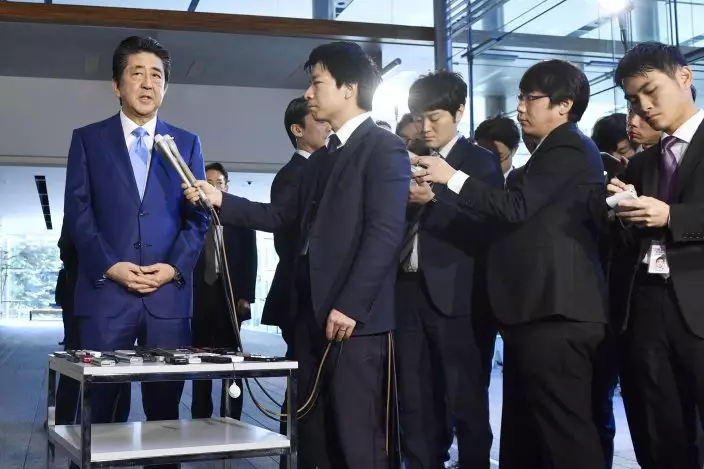Prime Minister Shinzo Abe made history Wednesday by becoming Japan’s longest-serving political leader, though he hasn’t achieved his biggest goal of revising the nation’s pacifist constitution.
Abe marked his 2,887th day in office, surpassing Taro Katsura from the early 20th century.
“Day by day, I have made efforts to achieve the policies that I have promised, and because of these daily efforts I’m here to mark this day,” Abe told reporters.

Japan's Prime Minister Shinzo Abe, left, speaks to media at his office Wednesday, Nov. 20, 2019, in Tokyo. Abe has made history by becoming Japan’s longest-serving political leader, though he hasn’t achieved his biggest goal of revising the nation’s pacifist constitution. (Kyodo News via AP)
Following his disappointing 2006-2007 term, Abe returned to office in 2012 and has since bolstered Japan’s defense role but hasn’t yet been able to change the constitution to allow a full-fledged military.
Abe has been stepping up his effort for such a change before his party leadership, his third term, ends in September 2021. That, however, is a challenge because of the lack of public interest.
Abe must obtain approval by two-thirds of both houses of parliament plus a majority in a national referendum to make any revision to the constitution.
Abe on Wednesday renewed his pledge to beat deflation, tackle Japan's aging and declining population and achieve a constitutional revision.
He said he still have two more years left in his current term as head of the ruling Liberal Democratic Party, pledging to tackle the unfinished political goals.
Abe’s resignation after his scandal-laden first time was the beginning of six years of annual leadership change, remembered as the era of “revolving door” politics that lacked stability and long-term policies.
When he returned to office in 2012, he vowed to revitalize the nation and get its economy out of the deflationary doldrums that had weighed on growth for years, after the implosion of the country’s financial bubble in the early 1990s.
His “Abenomics” formula of stimulating consumer demand through government spending, massive injections of cash into the economy via central bank purchases of government bonds and other assets and sweeping structural reforms has kept the economy growing, but at a much slower rate than promised. Boosting growth remains a challenge given the fast aging of Japan’s workforce and its shrinking population.
The Bank of Japan has stuck to its policy of keeping credit ultra-loose, with its key interest rate at minus 0.1% and tens of billions of yen (billions of dollars) in asset purchases a year. But consumer spending has not kept pace with expectations thanks to stagnant growth in wages and a shifting of much corporate investment into faster growing, more dynamic overseas markets.
Abe has made only halting progress with reforms intended to improve productivity and open up the labor market.
AP Business Writer Elaine Kurtenbach contributed to this report from Beijing.


